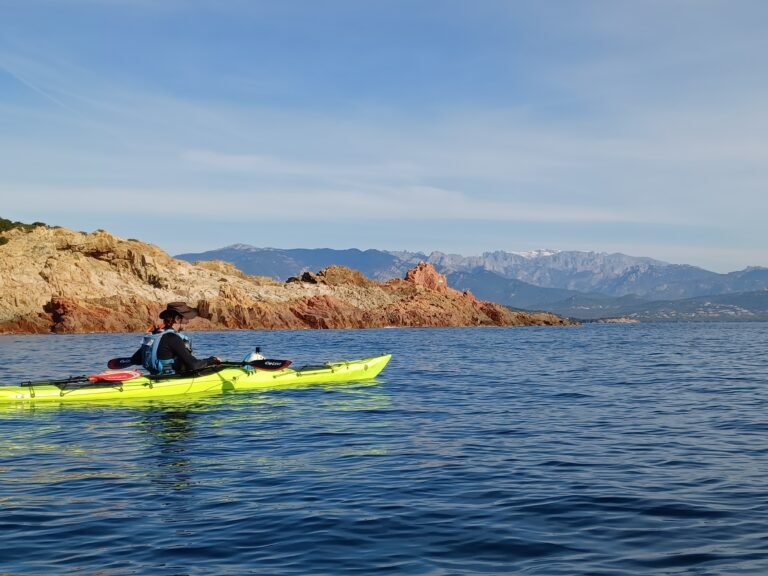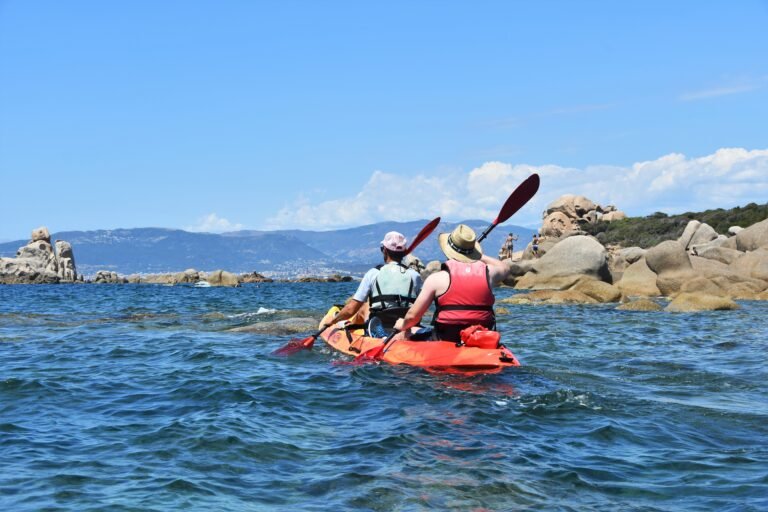Sea kayaking around Corsica : the projet
Put theory …
I visited Corsica many years ago on a climbing holiday and remember clearly thinking at the time that it would be a great place for sea kayaking. Thirty years later I eventually made it back with a plan to paddle all the way around this amazing island. I work as a sea kayaking guide on Sherkin, a small island off the southwest coast of Ireland. I run my business, H2O Sea Kayaking, there during the summer months where I run half-day tours, full-day tours, 3-day sea kayaking safaris, and bespoke training and skills workshops. My busy season starts in June so with my wife, Tina, we decided to go to Corsica in mid-April and gave ourselves a month to complete our expedition.
The planning started months beforehand and the first task was to find somewhere we could hire suitable kayaks. We had decided early on that we were not going to try to bring our own from Ireland, simply due to the logistical challenge. I contacted every kayaking provider I could find in Corsica and asked them all the same question – could they hire me two kayaks for a month in April/May? One of the few that responded was Cors Aventure.
… into practice
I started a conversation with Pierre Francois and then later, Marion. They were both very helpful in the lead-up to our journey. They have a good selection of kayaks to suit people of different sizes so we were able to pick two that suited us.
In the weeks before our departure, our house was full of camping and kayaking gear all over the place. We pulled out our tent, sleeping bags, paddling gear, and bought some new pieces of kit to bring with us. On departure day we had 30kg of bags each ! We traveled from Sherkin Island to catch two flights from Dublin and then Nice to arrive into Ajaccio late one Wednesday evening.
The next morning we met with Pierre Francois and Marion. They would become our guardian angel during our trip. The kayaks were perfect – big stable Prijons with rudders and large wide-opening hatches. They weren’t speed machines but they were perfect for our purpose.
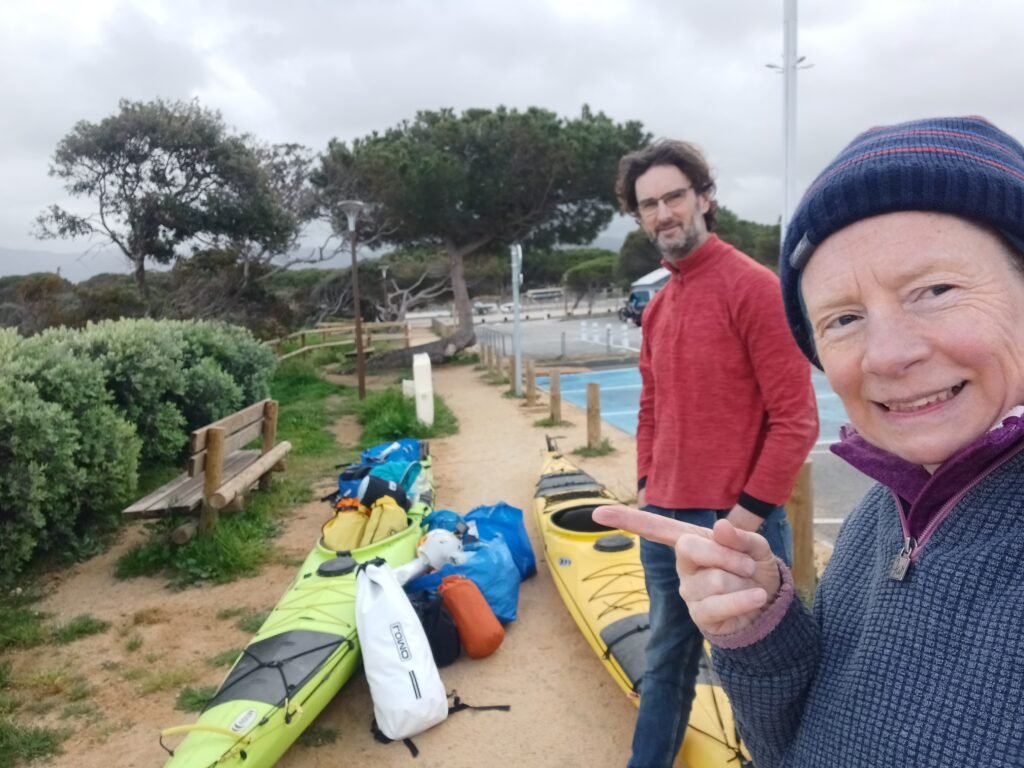
Sea kayaking in Corsica : first stages under the storm
Sea kayaking on the Mediterranean : how to summon your patience
We were ready to get in the water – but unfortunately, the weather was not ready to let us go. The wind and swell had been strong for days and there was no sign of it abating. We booked into a chalet in a nearby campsite and waited. On Saturday, Pierre Francois dropped us down to the beach at Isolella with our kayaks. The swell was still too big with surf breaking on the beach. We knew conditions would be a lot more difficult around the first headlands. The only thing we could do was wait. When darkness fell we put up a tent and waited until morning.
– A note on wild camping. Our understanding is that wild camping is not permitted in Corsica, especially in the Nature Reserves. On the other hand, bivouacking is allowed. The difference is subtle – you can have a tarp over your head and a ground sheet – just not a tent. We did break the rules by having a small tent, but only erected it late in the evening and were gone early the next morning and followed a strict “Leave No Trace” policy.
The first sailing in Corsica

At last on Sunday morning, the conditions had improved. Not flat calm by any means, but much better. We packed up and were on the water by 08:30 am. As we cleared the first headland the swell picked up. It was big enough that we sometimes couldn’t see each other if we were both in the troughs of the waves. That’s about 1m of swell. It was exciting – for now ! As we crossed from Punta di a Castagna to Capo di Muru, the swell increased. As did the wind. This was a committing crossing with over 10km before we could land.
Being our first day on the water this was not ideal. Tina started feeling seasick but also terrified, which did help to quell the nausea ! I stuck close to her, urging her along as the waves bounced us around until we eventually rounded what we came to know as Cap Guardiola. As soon as we did we were in calmer waters and found a beach we could land on. It was a surf landing on a steep beach which made it tricky but we were soon settled into our campsite for the night. It was the first of many isolated beaches that we had all to ourselves.
The Southwest coastline and the arrival at Bonifacio
Sea kayaking in Corsica : sailing around the Southwest coast
Our second day was a complete contrast to Day 1, with calm seas and light winds. This was more typical of the conditions we had over the rest of the journey, though there were a few days when the swell and wind picked up again. After the excitement of the previous day, we took our time packing up and got on the water mid-morning. With the best will in the world, between waking and paddling away from the beach, 2 hours will pass, though by the end of the trip we had become more efficient and had cut that down to 1.5 hours.
At a relaxed pace, we paddled on southeastwards to Porto Pollo where we stopped in the hope of resupplying. Why we needed to restock so soon I have no idea ! A pattern soon emerged, that we would stop for supplies every 2 or 3 days. The supermarket was closed for a long afternoon lunch. This is something we’re not used to in Ireland but soon got used to it.
The harsh reality of sea kayaking in Corsica
After a nap on the beach, we headed on. We had the choice of following the coast inland towards Propriano or cutting straight across the bay to Campomoro. A distance of about 9km. When deciding our route we considered whether there would be good spots to camp for the night away from built-up areas but also with safe places to land. We could see breaking surf on the beaches near Propriano so made the call to head straight across.
This was still a relatively long crossing, especially considering our training in preparation for the expedition consisted entirely of “wait training”. In other words wait until we get there ! It was a two-hour crossing and by the end of it, Tina was exhausted. She won’t mind me saying this because by the end of the trip, she was super fit and was showing off her muscles to everyone ! The beach we landed on was very public. We waited until dark to put up the tent. Most of the time we managed to avoid camping in such public places but it was unavoidable this day.

Sea kayaking in Corsica : Bonifacio and its amazing cliffs

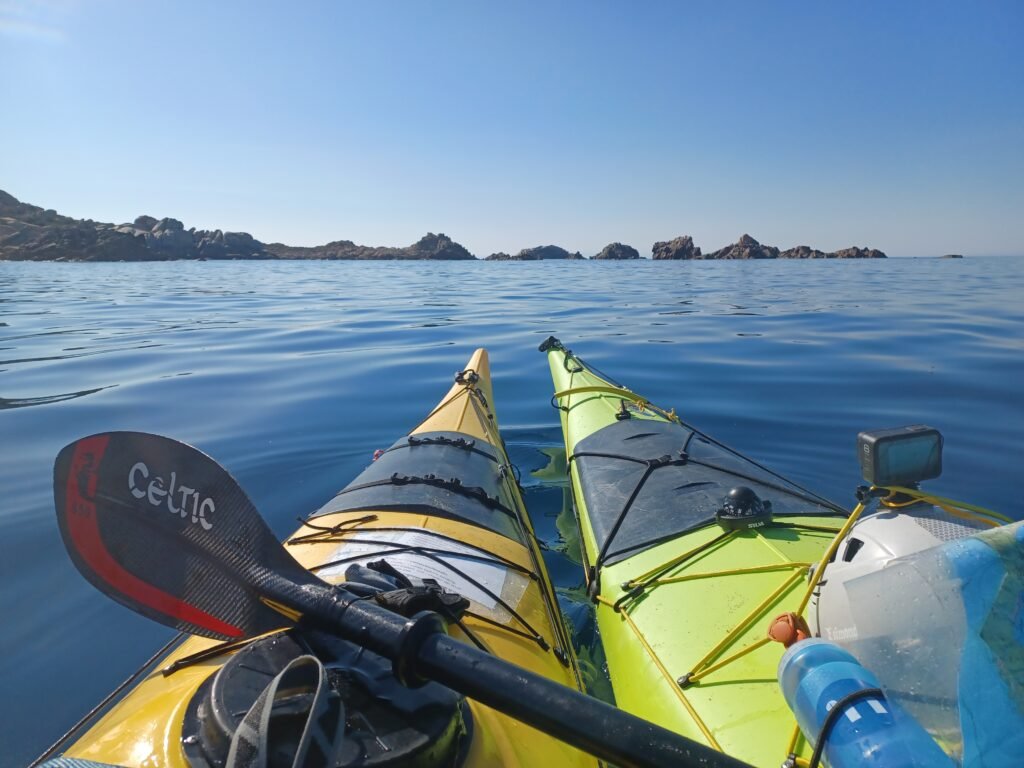
Before we started out on the trip we had agreed with Marion to keep her updated on our progress via WhatsApp. We sent her brief updates most days. She would let us know about any weather systems coming in that might cause us problems. We did keep a close eye on the forecasts ourselves too, of course. But it was fantastic to have her local knowledge.
The next few days were spent paddling along the beautiful and remote coastline from headland to headland where the sculptured granite rock was the backdrop until we approached Bonifacio. There the geology changed dramatically to the famous limestone cliffs this area is known for. While the port of Bonifacio is beautiful, the marine traffic, noise, and general busyness of the place meant we were happy to leave after we had stocked up on food and water. We enjoyed meandering along the cliffs and into mind-blowing caves straight out of the movie “The Beach”. After less than 10km, the limestone cliffs dropped away to a less spectacular but still pleasant coastline.
Sailing around the Eastern coast and our daily organisation
Bivouac ont the Corsican Coasts : some rules need to be followed
As the days continued, a similar pattern emerged. We woke with the daylight and I packed away the tent and sleeping bags. Tina would make our breakfast of cereal and tea, and sometimes sandwiches for the day. We were usually on the water before 8:30 and would paddle a couple of hours before stopping for a morning tea break. We usually didn’t have a fixed destination for the day but instead had a target distance we’d like to cover, which increased as our fitness levels improved.
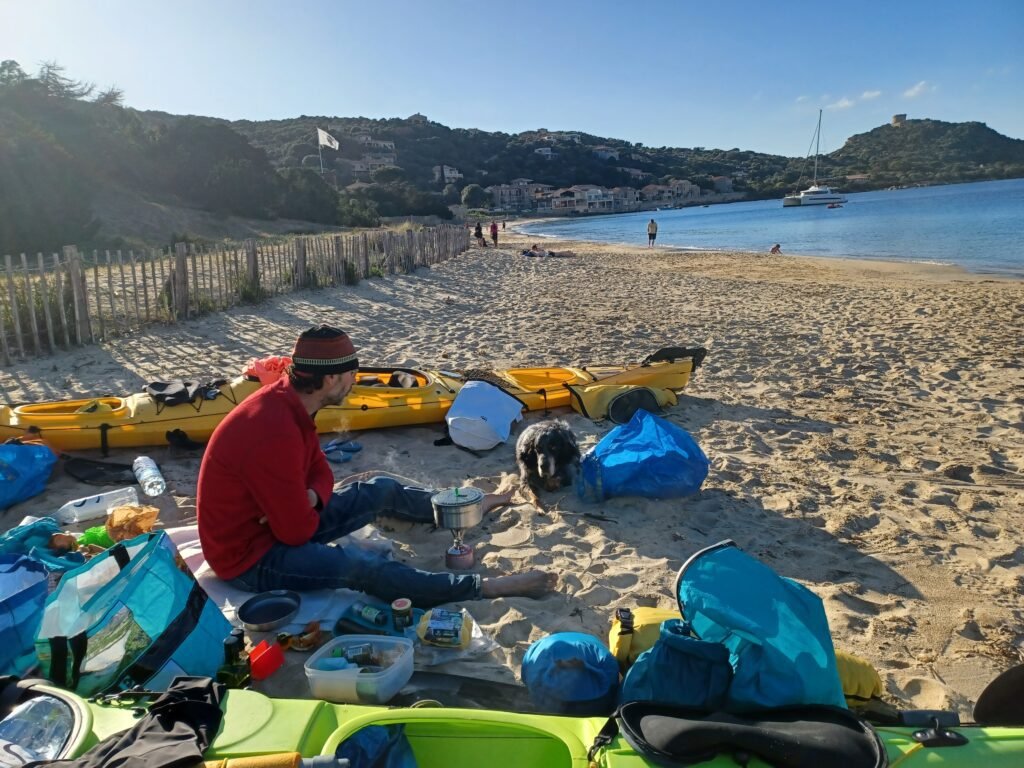
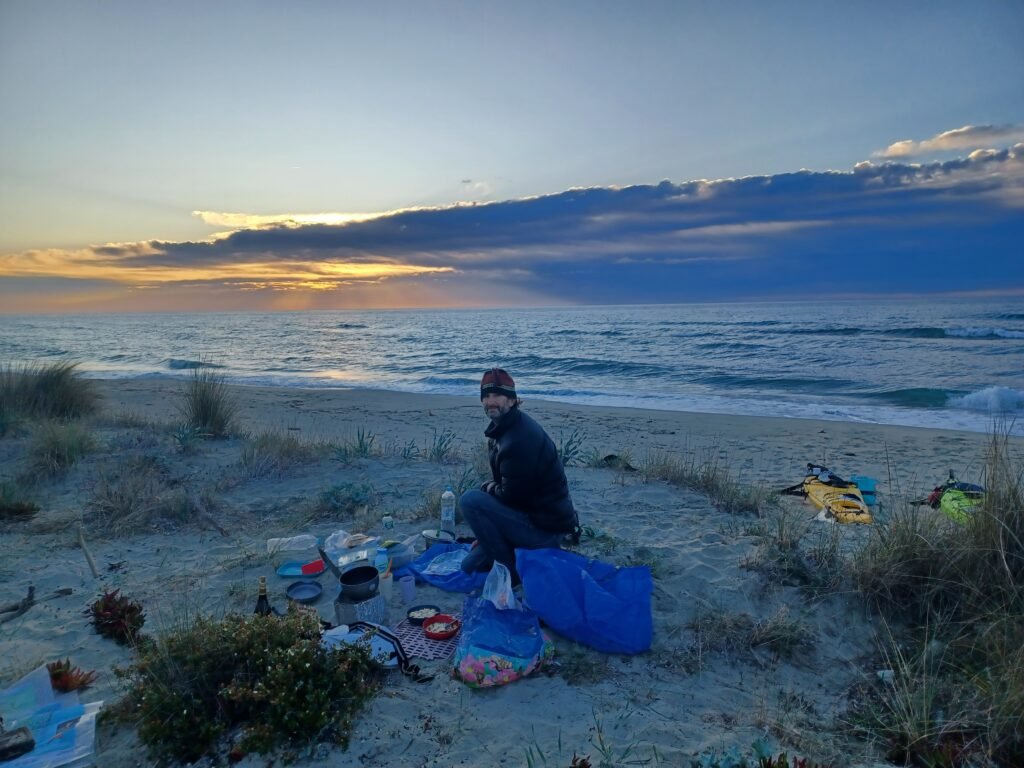

I kept track of our speed and distance with a handheld Garmin. I would give Tina “status updates” as we paddled along. We stopped for an early lunch and then an afternoon tea break too… it was very important to manage the tea levels. This became a central theme of our trip!
By mid-afternoon we were on the lookout for a campsite for the night. We were usually installed somewhere by 4:00 pm, watching the world go by, writing up the diary, and cooking up a dinner of veggies, lentils, rice, or pasta. If we weren’t in a nature reserve we would often light a fire on the beach with the abundant dry driftwood on the beaches – always being very careful and with water nearby to put it out quickly if needed. Later in the full height of summer, campfires on the beach probably would be a bad idea due to the high risk of brush fires. We were asleep in our tent by 9:00 p.m. and always slept like logs with the sound of the waves always in the background.
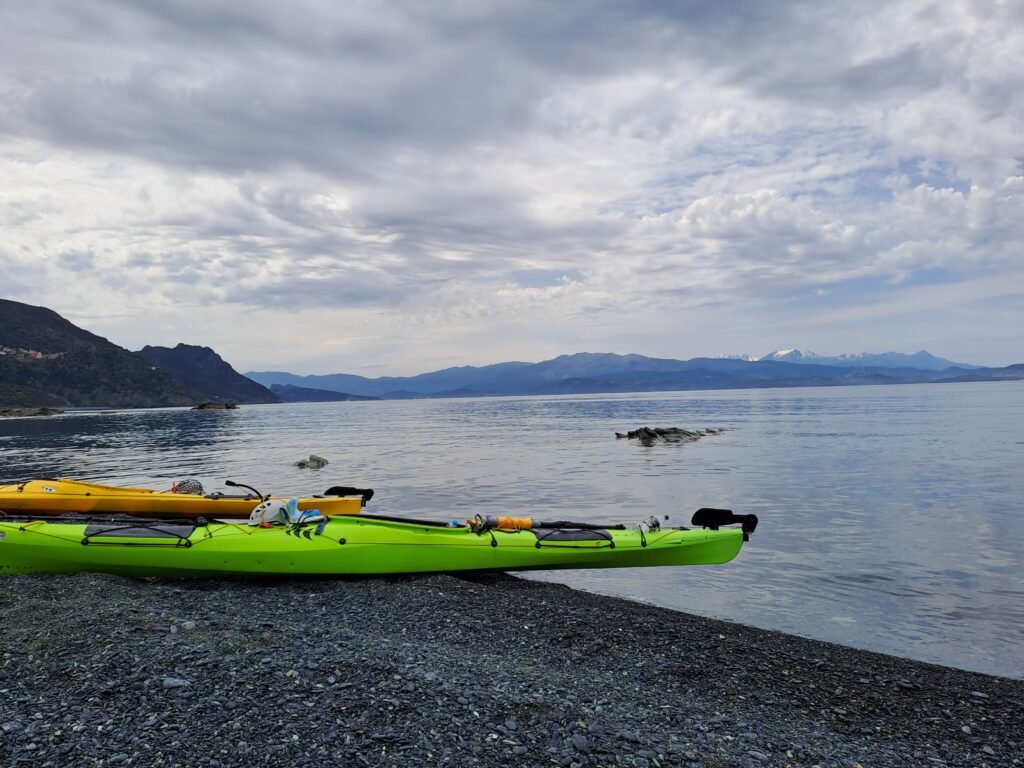
Sea kayaking in Corsica : go off to discover the Eastern Coast
A main feature of the east coast of Corsica is a beach that’s about 100km long. It is broken up only by towns, small rivers flowing out, and the ubiquitous towers on anything resembling a headland which are dotted the entire way around Corsica. I had initially not been looking forward to this section of our expedition because I thought it would be a bit monotonous. However, while there was a degree of “sameness” about the landscape, the views of the mountains in the distance were always present. The changing sea state provided enough variety to our days. The wind and swell picked up as we made our way northwards which gave us some excitement as we launched and landed through surf.
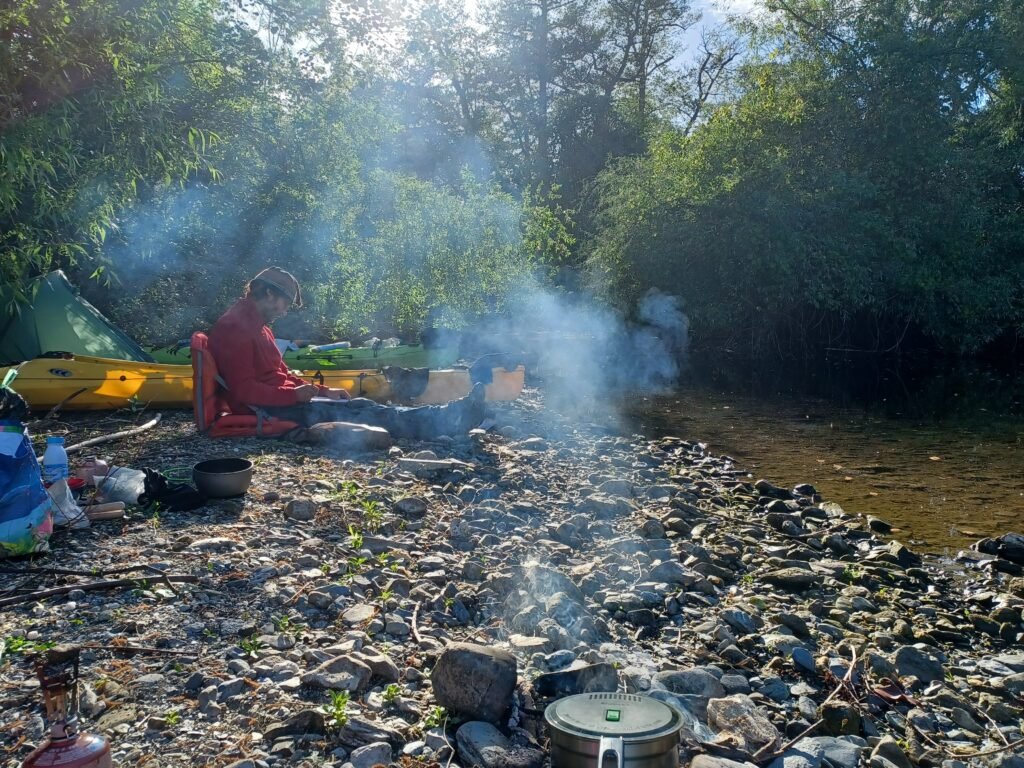
On the 9th day of our trip, there was an offshore wind and breaking surf so we stopped for a break after 7km. We took the remainder of the day off to rest and chill out. One notable campsite was when we found a river flowing into the sea. Most of the rivers we came across were so shallow and dry it was impossible to travel upstream. The Bucatoggio river was a little different. Despite only being 10km from source to sea there was enough water to paddle upstream for a couple of hundred metres at least.
We set up camp in the trees, away from the persistent sound of the sea – which was nice. However it was also good to have a change. We washed ourselves and some of our salt-encrusted gear in the fresh water. Then we settled in for a peaceful night…until a couple of scops owls decided to have a chat… all night long. The scops owl has a call akin to the most boring phone call tone available. It is repetitive in the extreme so our sleep was not so sound that night!
Sea kayaking in Corsica : sailing from Bastia to Calvi
The Cap Corse area
We landed in Bastia on a busy morning to the sound of the church bells ringing in the old harbour. We were in search of gas for our stove. Indeed we were running low on the ones that Pierre Francois had bought for our MSR stove before we arrived. Gas being one of the things that we couldn’t bring with us on the plane. In the end, we simply couldn’t find it. We ended up buying a simple stove with amore readily available canister.
For the next couple of days, we paddled northwards to one of the more notorious parts of the Corsican coast – the Cap Corse. This is the most northerly point of the island has a reputation for strong winds and big seas. As it turned out for us, we had ideal conditions with the wind at our backs or flatcalm seas which we made the most of. Once again the landscape changed here. The Cap definitely has a more rugged, remote feel and there are several long stretches where it would not be possible to land in rough seas.
Just north of the tourist town of St Florent we stopped at a proper campsite right on the beach. We had our first hot shower in two weeks. It was the best shower ever ! The next morning we paddled into town to resupply. The next part of our journey around the Désert des Agriate was very remote, with no towns or roads for over 40km. If we were forced off the water by bad weather we’d need some food in reserve to see us through. The weather was getting unsettled for sure.
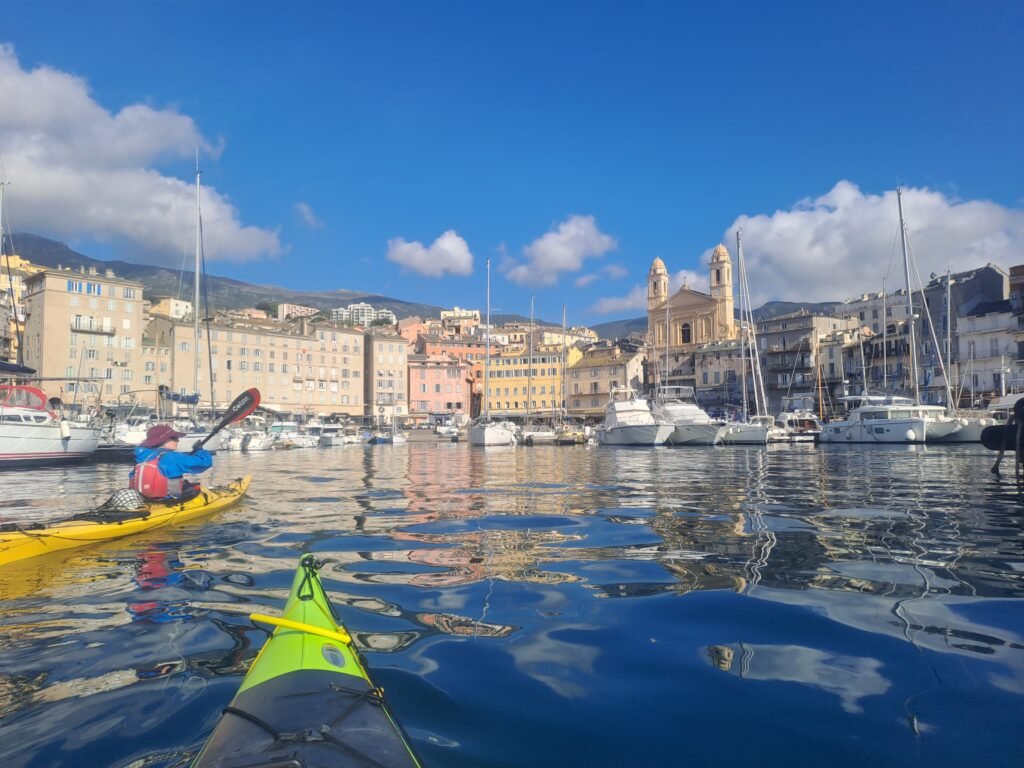
Sailing around the famous Agriates Desert
We paddled out of St Florent with a good wind at our backs and then turned east along this stunning coastline with pristine beaches and blue waters even though it was overcast and drizzly. In the high season, there is no doubt that there would be throngs of yachts and powerboats moored here with hundreds of people sunbathing and swimmers in the water. But we had the whole coast almost entirely to ourselves apart from a couple of hikers on a coastal path.
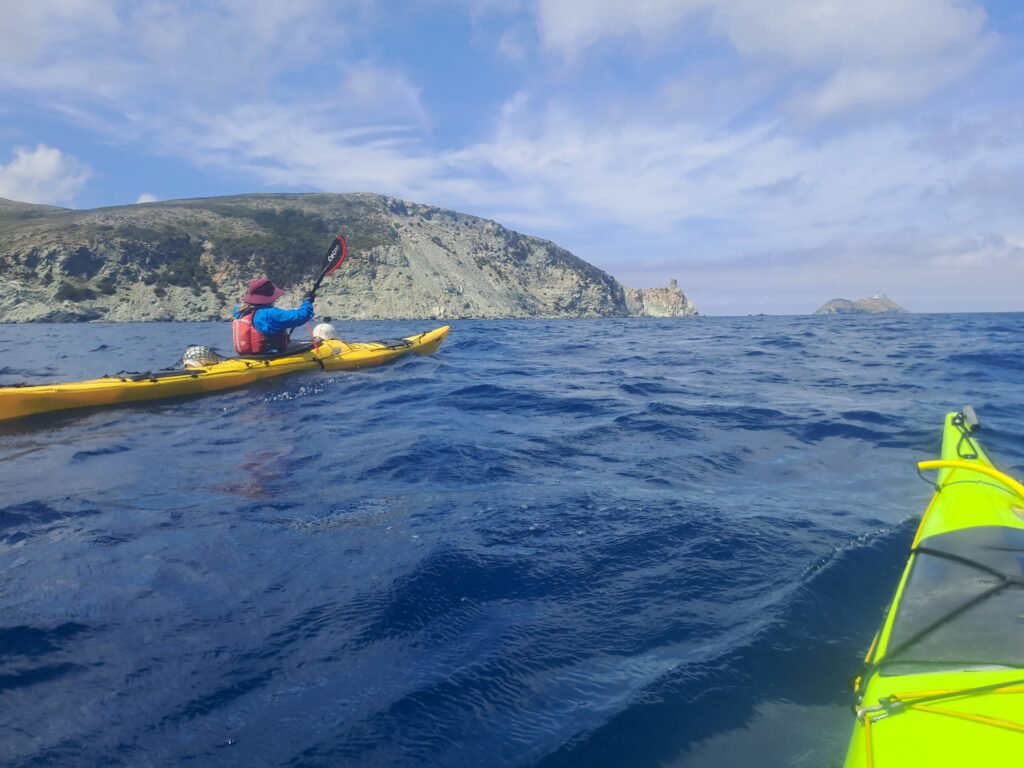
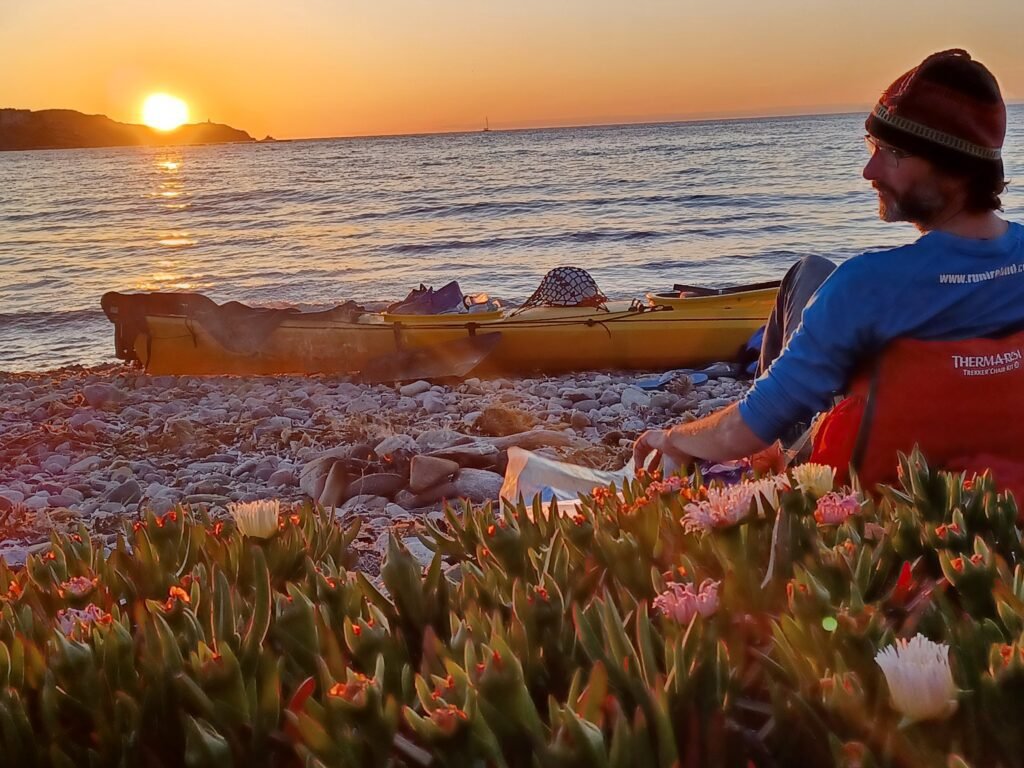
We camped in the rain that night in a grassy field. Our first night not camped on sand or gravel so far. Tina refers to as the “cow shit” camp! It’s not inaccurate but – hey – it’s wild camping!
Over the next couple of days, the weather worsened. By the time we arrived at Ile Rousse we had to land through sizeable surf on a beach. We ended up taking our first and only full day off the next day. It was a well-earned break which we used to read and write up our diary as well as top off our supplies for the days ahead. The swell had not dropped by the next morning, though the wind had subsided. I had some fun in the surf, catching a couple of nice clean waves before the serious work of the day got underway.
The arrival in Calvi
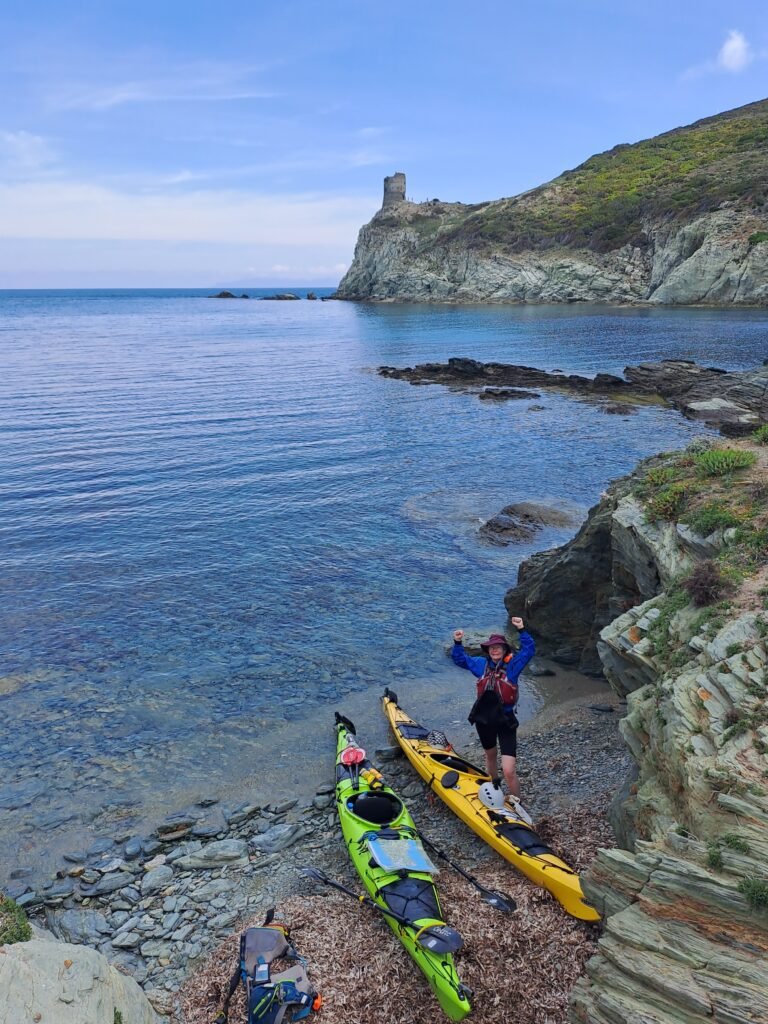
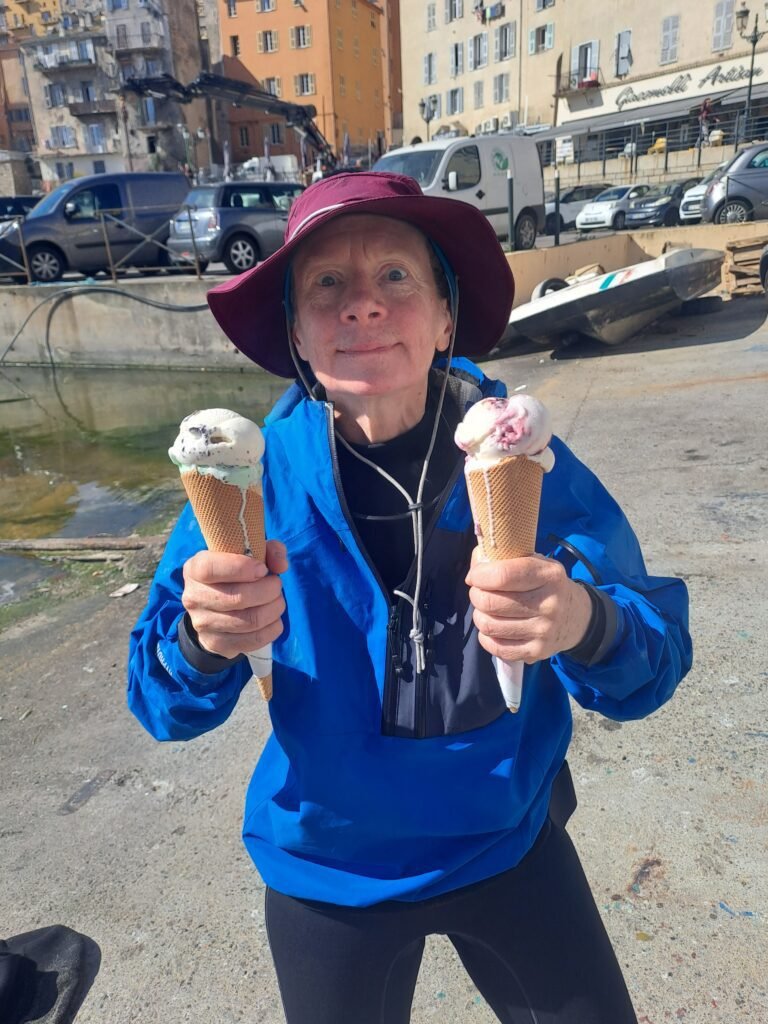
The wind and swell both picked up as the day went on. By the time we arrived in Calvi we were ready for a huge ice cream while sitting outside a fancy café on the waterfront, dressed in our full paddling gear while getting some funny looks from the well-heeled tourists ! Because of the lack of a quiet spot to camp for the night, and deteriorating conditions on the water, we had to backtrack. We were fighting against the wind for an hour to find a spot to put up our tent. Our reward for that was the most amazing sunset behind the citadel of Calvi.
Sea kayaking in the Scandola Reserve and the Calanques de Piana
The Scandola Reserve
The most scenic and striking part of our circumnavigation was over the next few days from Calvi to Cargese. In these 70km or so is the well-known Scandola National Reserve which we had heard about well before our arrival. It deserves the reputation it has earned as the high cliffs, deep caves, and untouched beaches are truly beautiful. We arrived there early in the morning having left from Galleria. As we arrived, so did the first of the tourist boats ferrying people out from Porto in fast, loud vessels.
While we enjoyed the place – we were also glad to have arrived early to see some of the wonders in peace and quiet. We had our one and only run-in with the skipper of one of these speed boats when we stopped for a very quick bite to eat on a rock – there being no beach we could land on. He shouted abuse at us and threatened us with being fined for simply landing. Then he drove off with his clients in his loud craft, spewing fumes!
How majestic are the Calanques de Piana
The following day, (after stopping for the night outside of the Nature Reserve) we paddled into Porto, exploring our first through cave of the trip along the way, to replenish our stocks. We had considered just cutting across Porto Bay to save time and distance. However we were very glad to have explored that beautiful part of Corsica. It is a small town nestled in between mountains reminiscent of the Dolomites.
The headland of Capo Rosso was even more spectacular than Scandola and we were there very early in the morning having stopped nearby the night before. The maze of caves and channels running through the headland is so beautiful and fun to explore. We took our time lingering there, watching the swifts that nest on the cliffs before carrying on southwards.
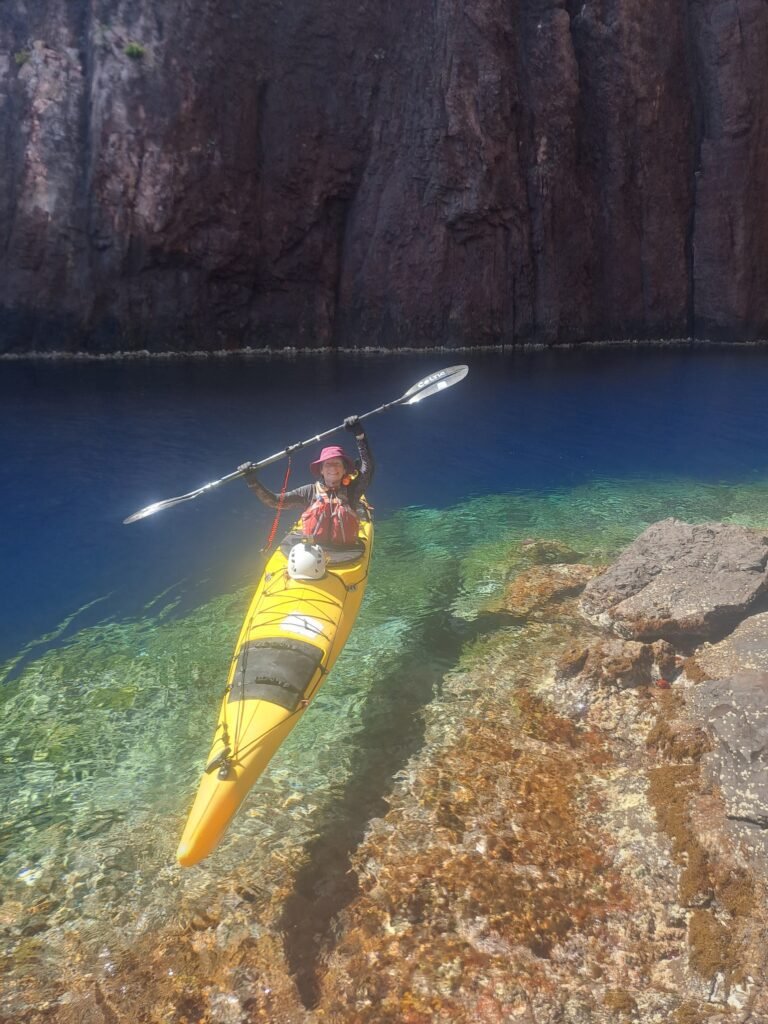
To bring things full circle : back to Ajaccio
Sa kayaking in Corsica : The final push !
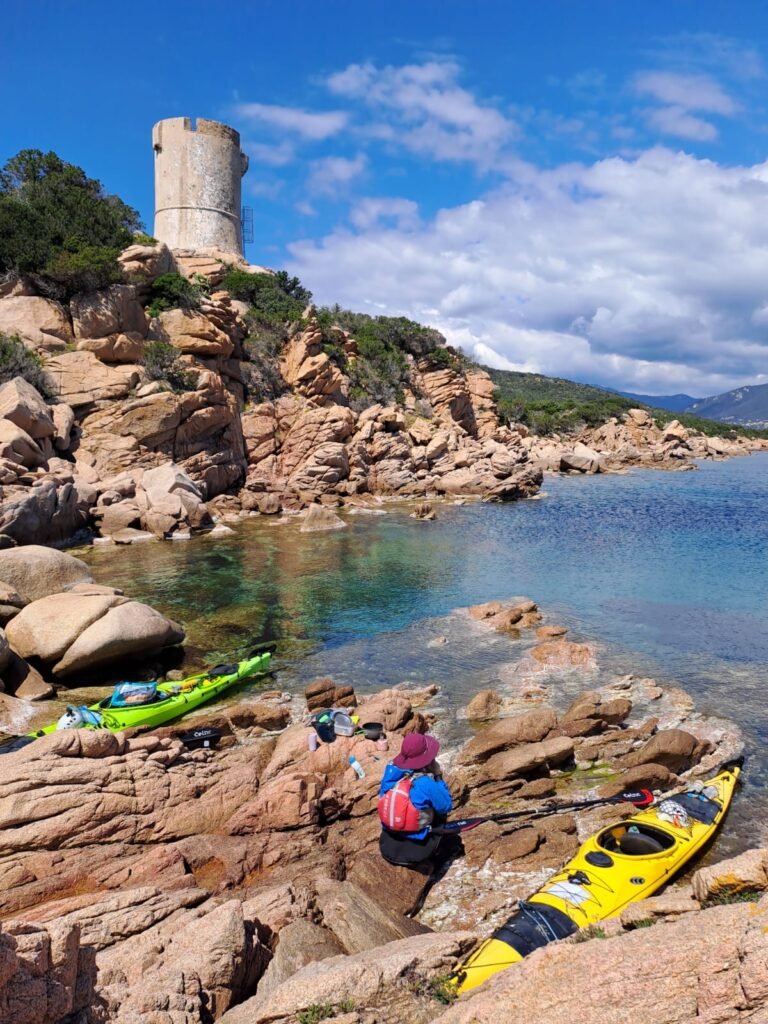
At the start of the expedition, we had lost three days due to bad weather. After that setback, we thought our chances of completing the complete circumnavigation in the time we had left were slim. But after a few days our fitness started to improve and our daily mileage increased bit by bit. Towards the end of the journey we paddled two days straight of 38 km. Much more than the average 20km per day we had initially envisioned. We are both competitive by nature so enjoyed pushing ourselves on days when the scenery was slightly less stunning !
On the last few days of the trip we were getting messages from Marion that there were some bad weather conditions coming in so this is when we really pushed on. The last thing we wanted was to be 10km from the end of the journey to find ourselves pinned down on a beach by bad weather. So we raced ahead to make sure that didn’t happen.
Back to the start : the end of the trip
When we rounded Pointe de la Parata into the bay of Ajaccio and in the distance Isolella we were over the moon. Our last camp was just 10km short of the finish line. While we were weary and looking forward to a hot shower, there was a definite tinge of sadness now that the journey was almost over. It had been an amazing journey.
The simple nature of the trip; waking, eating, paddling, and sleeping – repeat – was very special and something neither of us will forget. After 23 and a half days, we arrived back at our starting point after the longest crossing of the trip. Pierre Francois welcomed us at the beach where we handed back our trusty kayaks. We checked into the chalet again for our first night in a real bed for ages !
If you’d like to see a day by day account of our sea kayaking journey in Corsica. You can watch the full YouTube video here.
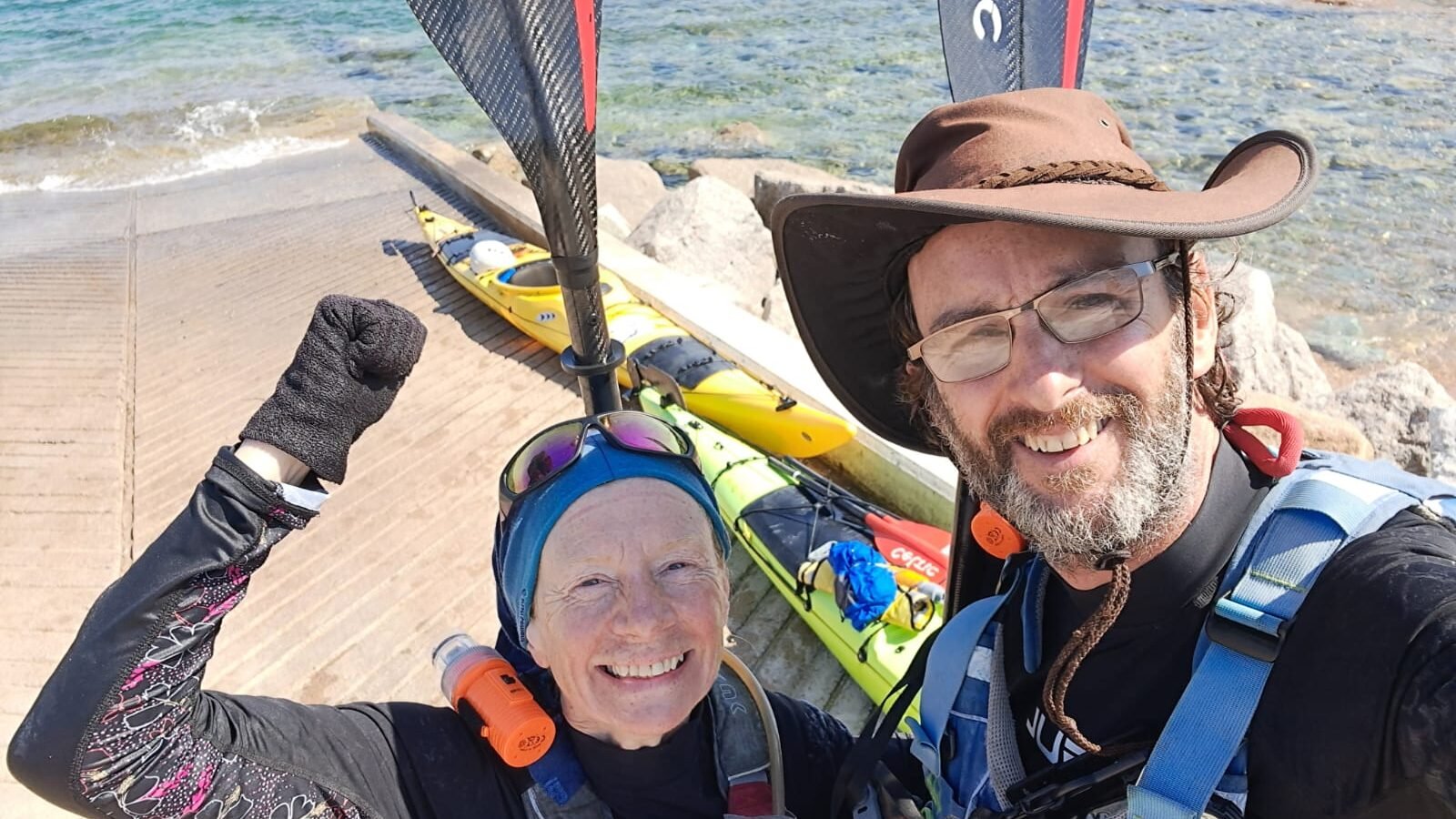
Tina and Pat took all these pictures and wrote this journal. All rights are reserved to them. We published their sea kayaking expedition around Corsica with their agreement. If you want to read their expedition in French, here is the translated article !




